
The Battle of the Little Bighorn, known to the Lakota and other Plains Indians as the Battle of the Greasy Grass and also commonly referred to as Custer's Last Stand, was an armed engagement between combined forces of the Lakota Sioux, Northern Cheyenne, and Arapaho tribes and the 7th Cavalry Regiment of the United States Army. The battle, which resulted in the defeat of U.S. forces, was the most significant action of the Great Sioux War of 1876. It took place on June 25–26, 1876, along the Little Bighorn River in the Crow Indian Reservation in southeastern Montana Territory.

The Battle of Culloden was the final confrontation of the Jacobite rising of 1745. On 16 April 1746, the Jacobite army of Charles Edward Stuart was decisively defeated by a British government force under Prince William Augustus, Duke of Cumberland, on Drummossie Moor near Inverness in the Scottish Highlands. It was the last pitched battle fought on British soil.

The Battle of Shiloh was an early battle in the Western Theater of the American Civil War, fought April 6–7, 1862, in southwestern Tennessee. The battle is named after a small church in the vicinity named Shiloh which ironically translates to "place of peace" or "heavenly peace". The Union Army of the Tennessee had moved via the Tennessee River deep into Tennessee and was encamped principally at Pittsburg Landing on the west bank of the Tennessee River, where the Confederate Army of Mississippi launched a surprise attack on Grant's army from its base in Corinth, Mississippi. Johnston was mortally wounded during the fighting; Beauregard took command of the army and decided against pressing the attack late in the evening. Overnight, Grant was reinforced by one of his divisions stationed farther north and was joined by three divisions from the Army of the Ohio. The Union forces began an unexpected counterattack the next morning which reversed the Confederate gains of the previous day.
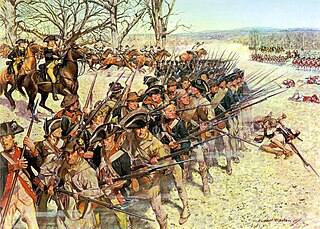
The Battle of Guilford Court House was on March 15, 1781, during the American Revolutionary War, at a site that is now in Greensboro, the seat of Guilford County, North Carolina. A 2,100-man British force under the command of Lieutenant General Charles Cornwallis defeated Major General Nathanael Greene's 4,500 Americans. The British Army, however, suffered considerable casualties.

The Battle of Trenton was a small but pivotal American Revolutionary War battle that took place on the morning of December 26, 1776, in Trenton, New Jersey. After General George Washington's crossing of the Delaware River north of Trenton the previous night, Washington led the main body of the Continental Army against Hessian auxiliaries garrisoned at Trenton. After a brief battle, almost two-thirds of the Hessian force was captured, with negligible losses to the Americans. The battle significantly boosted the Continental Army's waning morale, and inspired re-enlistments.
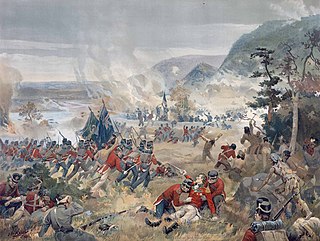
The Battle of Queenston Heights was the first major battle in the War of 1812. Resulting in a British victory, it took place on 13 October 1812 near Queenston, Upper Canada.

Major General Sir Edward Michael Pakenham,, was a British Army officer and politician. He was the son of the Baron Longford and the brother-in-law of the Duke of Wellington, with whom he served in the Peninsular War. During the War of 1812, he was commander of British forces in North America (1814–15). On 8 January 1815, Pakenham was killed in action while leading his men at the Battle of New Orleans.
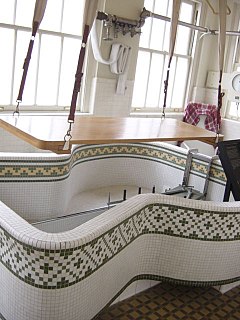
Hydrotherapy, formerly called hydropathy and also called water cure, is a part of alternative medicine, occupational therapy, and physiotherapy, that involves the use of water for pain relief and treatment. The term encompasses a broad range of approaches and therapeutic methods that take advantage of the physical properties of water, such as temperature and pressure, for therapeutic purposes, to stimulate blood circulation and treat the symptoms of certain diseases.

The Battles of Frenchtown, also known as the Battle of the River Raisin and the River Raisin Massacre, were a series of conflicts in Michigan Territory that took place from January 18–23, 1813, during the War of 1812. It was fought between the United States and a British and Native American alliance near the River Raisin in Frenchtown,.

The siege of Lexington, also known as the First Battle of Lexington or the Battle of the Hemp Bales, was a minor conflict of the American Civil War. The siege took place from September 13 to 20, 1861 between the Union Army and the pro-Confederate Missouri State Guard in Lexington, county seat of Lafayette County, Missouri. The victory won by the Missouri Guard bolstered the considerable Southern sentiment in the area, and briefly consolidated Missouri State Guard control of the Missouri River Valley in the western part of the state.

The Battle of St. Michaels was an engagement contested on August 10, 1813, during the War of 1812. British soldiers attacked the American militia at St. Michaels, Maryland, which is located on Maryland's Eastern Shore with access to Chesapeake Bay. At the time, this small town was on the main shipping route to important cities such as Baltimore and Washington, D.C.

George Washington's crossing of the Delaware River, which occurred on the night of December 25–26, 1776, during the American Revolutionary War, was the first move in a surprise attack organized by George Washington against Hessian forces in Trenton, New Jersey, on the morning of December 26. Planned in partial secrecy, Washington led a column of Continental Army troops across the icy Delaware River in a logistically challenging and dangerous operation.

The 69th New York Infantry Regiment is an infantry regiment of the United States Army. It is from New York City, part of the New York Army National Guard. It is known as the "Fighting Sixty-Ninth", a name said to have been given by Robert E. Lee during the Civil War. An Irish heritage unit, as the citation from poet Joyce Kilmer, illustrates, this unit is also nicknamed the "Fighting Irish", immortalized in Joyce Kilmer's poem When the 69th Comes Home. Between 1917 and 1992 it was also designated as the 165th Infantry Regiment. It is headquartered at the 69th Regiment Armory in Manhattan.

The Battle of Jenkins' Ferry, also known as the Engagement at Jenkins' Ferry, was fought at Jenkins' Ferry, southwest of Little Rock, during the American Civil War. It was the climactic battle of Steele's Camden Expedition, a part of the Red River Campaign. As a result of the battle, Federal forces could complete a retreat from a precarious position at Camden to their defenses at Little Rock.
In the Siege of Jadotville[ʒa.do.vil] in September 1961, a small contingent of Irish troops serving as part of the United Nations Operation in the Congo were besieged in the mining town of Jadotville by Katangese forces loyal to the secessionist State of Katanga. The siege took place during the seven-day escalation of a stand-off between ONUC and Katangese forces during Operation Morthor. Although the Irish soldiers resisted Katangese attacks for five days while a relief force of Irish, Indian and Swedish troops attempted to reach them, they were eventually forced to surrender. They were subsequently held as prisoners of war for approximately one month.

The Cholas were a Tamil kingdom of the pre and post Sangam period. It was one of the three main kingdoms of South India. Their early capitals were Urayur or Tiruchirapalli and Kaveripattinam. Along with Pandyas and Cheras, Chola history goes back to the period when written records were scarce.

Castletownroche is a townland, village, and civil parish in the barony of Fermoy, County Cork, Ireland. It is located on the N72 national secondary road. In ancient times, it was known in Irish as Dún Chruadha, meaning Cruadha's Fort. Castletownroche is located on the River Awbeg in the Blackwater Valley about eight miles (13 km) from Mallow. Castletownroche is within the Cork East Dáil constituency.
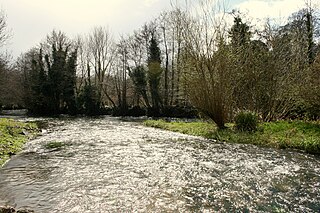
Awbeg River is a river in the southern part of Ireland. It is a tributary of the Blackwater River and flows into that larger river at a point in County Cork. Its name comes from the Irish Abha Bheag.
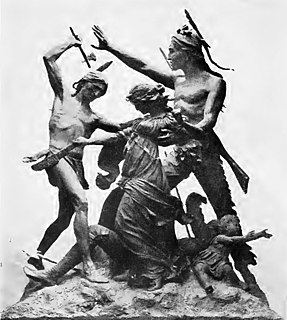
Black Partridge or Black Pheasant was a 19th-century Peoria Lake Potawatomi chieftain. Although a participant in the Northwest Indian War and the War of 1812, he was a friend to early American settlers and an advocate for peaceful relations with the United States. He and his brother Waubonsie both attempted to protect settlers during the Battle of Fort Dearborn after they were unsuccessful in preventing the attack.

The Great Lakes Patrol was carried out by American naval forces, beginning in 1844, mainly to suppress criminal activity and to protect the maritime border with Canada. A small force of United States Navy, Coast Guard, and Revenue Service ships served in the Great Lakes throughout these operations. Through the decades, they were involved in several incidents with pirates and rebels.


















